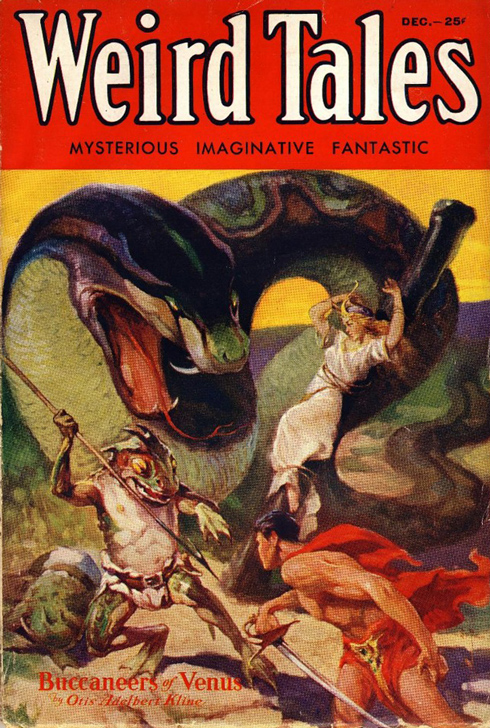Part one of a three part series. Check back at this link to read them all.
Know, O Reader, that long before anybody thought of making a Conan movie, long before Arnold Schwarzenegger was born or Marvel’s Conan the Barbarian #1 appeared on the newstands, in 1932, to be precise, the world’s most famous Barbarian sprang to life in the pages of Weird Tales magazine under the byline of Robert E. Howard (1906-1936). Any suggestion that Conan is the work of many hands—some reference works will say “Robert E. Howard and others” is rather like saying Sherlock Holmes was created by “A. Conan Doyle and others.” No, there have been subsequent pastiches, reinterpretations, and movie adaptations, but the real, 100% bona fide Conan is Howard’s.
It’s not hard to explain why Howard was good. Read this:
The long tapers flickered, sending the black shadows wavering along the walls, and the velvet tapestries rippled. Yet there was no wind in the chamber. Four men stood about the ebony table on which lay the green sarcophagus that gleamed like carven jade. In the upraised right hand of each man a curious black candle burned with a weird greenish light. Outside was night and a lost wind moaning among the black trees.
Inside the chamber was tense silence, and the wavering of the shadows, while four pairs of eyes, burning with intensity, were fixed on the long green case across which cryptic hieroglyphics writhed, as if lent life and movement by the unsteady light. The man at the foot of the sarcophagus leaned over it and moved his candle as if he were writing with a pen, inscribing a mystic symbol in the air. Then he set down the candle in its black gold stick at the foot of the case, and, mumbling some formula unintelligible to his companions, he thrust a broad white hand into his fur-trimmed robe. When he brought it forth again it was as if he cupped in his palm a ball of living fire.
The other three drew in their breath sharply, and the dark, powerful man who stood at the head of the sarcophagus whispered: “The Heart of Ahriman!”
That’s from the first page of Howard’s only Conan novel, The Hour of the Dragon, serialized in Weird Tales, December 1935-April 1936 and published as Conan the Conqueror in some editions. The four sinister gentlemen are engaged in reanimating an ancient and very nasty sorcerer for the purpose of overthrowing Conan, now king of Aquilonia. But as it turns out, the sorcerer has an agenda of his own, even as does the mystical jewel, the Heart of Ahriman. The result is a rip-roaring adventure, complete with captures, escapes, ghouls, vampires, and thunderous battles, all told in the finest epic style. It may lack some of the sublime beauties of The Lord of the Rings, but it is one of the greatest classics of heroic fantasy.
Let’s examine that epic style for the moment. The passage quoted above is a little adjectival for some tastes, although these fashions shift every few years. But more to the point, notice how skillfully he uses his words. The adjectives are well chosen, for rhythm, atmosphere, or a direct appeal to the senses. It is visually striking that amid all that gloom, one man thrusts a “broad white hand” into his fur-trimmed robe. Why is it necessary to mention the fur trimming? As we rapidly learn, these men are high ranking noblemen, traitors to King Conan. Notice how quickly the background is filled in, and how the story gets going from a moment of tension, without any pause to lecture. One of the commonest mistakes amateurs make is, after a paragraph or two which attempts to grab the reader’s interest, a long verbal lump which can be summed up as, “And now a history of the world up to this point.” But a good writer does not have to do that, and Howard, writing with great efficiency and even poetic grace when at the top of his form, never did. L. Sprague de Camp, long one of Howard’s greatest champions and no mean fantasist himself, remarked about this passage that any writer would envy Howard’s skill as shown here.
De Camp said something else that is well worth repeating, which is that the absolutely essential characteristic for a successful storyteller is not a fine style or subtle characterization or any of numerous other literary virtues, but the ability to grab the reader’s attention and drag him along willy-nilly without letting go until the end. This is a talent that Howard had in spades. That he could create a great character, or conjure up such scenes of atmospheric menace as the one that opens The Hour of the Dragon is an added bonus.
H.P. Lovecraft, who wrote a moving obituary for Howard in Weird Tales, lauded the “incomparable vividness” of Howard’s tales and then singled out “one of his most effective accomplishments—the description of vast megalithic cities of the elder world, around whose dark towers and labyrinthine nether vaults clings an aura of pre-human fear and necromancy which no other writer could duplicate.” That’s extremely high praise coming from the 20th Century’s top purveyor of eldritch horrors!
Tomorrow: Who was Robert E. Howard?
Darrell Schweitzer is the author of The Mask of the Sorcerer, The Shattered Goddess, and The White Isle, in addition to about 300 published stories, most in the fantasy/horror area. He has been nominated for the World Fantasy Award four times and won it once, as co-editor of Weird Tales, a post he held for 19 years. He is widely published as a critic and reviewer, and is a regular contributor to The New York Review of Science Fiction. He has edited critical symposia about Robert E. Howard and H.P. Lovecraft, and is the author of a book-length study of Lord Dunsany.










